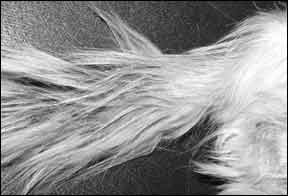In teenagers, the sebaceous glands contribute to the development of acne. In cats, these glands can cause a similar problem at the base of the tail, an accumulation of scale (flakes) and yellow-to-black waxy debris (blackheads) along the dorsal, or top, surface of the tail.

288
Although it can affect any cat who doesn’t groom the tail, the condition was once thought to affect only intact male cats, hence the name stud tail, says dermatologist William H. Miller, Jr., VMD, Medical Director of the Cornell University Hospital for Animals.
Medically, the condition is known as supracaudal gland hyperplasia or tail gland hyperplasia. It’s caused by hypersecretion of the glands in the supracaudal organ on the base of the tail.
Fortunately, most cats are fastidious about grooming their entire body, so stud tail is an uncommon occurrence, but some breeds such as Persians, Siamese and Rex may be more prone to it.
“It is recognized more in longhaired cats because their hairs are easily pasted together, but it can occur in any cat of any breed, of either gender, intact or neutered,” Dr. Miller says.
Stud tail isn’t simply unattractive. The debris that develops can plug the hair follicle, causing them to become infected, a condition known as secondary bacterial folliculitis. The hair can become matted, develop a rancid odor and fall out. In severe cases, the cat may develop boils or pustules, accompanied by pain and itching.
The first step in treating stud tail is to identify why the cat isn’t grooming properly and correct the situation if possible. For instance, if the cat is overweight and can’t easily reach the tail to groom it, a weight-loss plan may be needed.
If the cause for the lack of grooming is unknown, the condition can only be managed, not cured. You can use antiseborrheic treatments such as wipes, shampoos and spot application products to remove surface debris and keep the hair follicles open. Be sure to use only products recommended by your cat’s veterinarian. Shampoos or other products that contain coal tars or phenols can be toxic to cats. Cats with bacterial folliculitis may require a course of antibiotics. When the cause of stud tail is unknown, the tail area must be cleaned regularly to prevent the condition from recurring.



